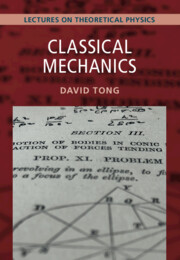
- Textbook
- Publisher:
- Cambridge University Press
- Online publication date:
- June 2025
- Print publication year:
- 2025
- Online ISBN:
- 9781009594530

Any education in theoretical physics begins with the laws of classical mechanics. The basics of the subject were laid down long ago by Galileo and Newton and are enshrined in the famous equation F=ma that we all learn in school. But there is much more to the subject and, in the intervening centuries, the laws of classical mechanics were reformulated to emphasis deeper concepts such as energy, symmetry, and action. This textbook describes these different approaches to classical mechanics, starting with Newton's laws before turning to subsequent developments such as the Lagrangian and Hamiltonian approaches. The book emphasises Noether's profound insights into symmetries and conservation laws, as well as Einstein's vision of spacetime, encapsulated in the theory of special relativity. Classical mechanics is not the last word on theoretical physics. But it is the foundation for all that follows. The purpose of this book is to provide this foundation.
‘This is theoretical physics ‘done right’. The author’s love of the subject and its history, as well as its results, shines through. The definitions and derivations are clean, but never dry. For students of modern physical science, these volumes will be a rich source of instruction, insight - and joy.’
Frank Wilczek - Massachusetts Institute of Technology
‘David Tong is one of those physicists who comes along only rarely. He unrelentingly dives into all fields of physics, recognising the often underappreciated unity of the body of knowledge that exists. He is a master of technical detail along with the essential underlying physical principles. In this series he covers much of the undergraduate and graduate curriculum with clarity and humour, and I often find myself looking up his books or using his efforts to teach better myself.’
Lisa Randall - Harvard University
‘This is a wonderful set of textbooks. A dynamic and engaging introduction to theoretical physics with a very modern emphasis.’
Juan Maldacena - Institute of Advanced Study, Princeton
‘These books are an invaluable gift to physics students of all ages. It's probably impossible for a series of books to cover everything a physicist needs to know, but this is as close as you're going to get - all explained with David Tong's characteristic clarity and verve. I can't recommend them highly enough.’
Sean Carroll - Johns Hopkins University, and author of Spacetime and Geometry: An Introduction to General Relativity
‘The books in this textbook series are destined to become classics and will be immensely popular among students and researchers alike. The writing is clear and accessible, and the style is engaging and witty. One cannot resist a comparison to the authoritative and deeply insightful set of books by Landau and Lifshitz. This series, aimed at an even broader audience, may well prove to be equally influential, establishing a ‘theoretical minimum’ to which all physicists should aspire. I cannot wait for the other volumes to appear.’
Sandip Trivedi - Tata Institute of Fundamental Research, Mumbai
‘David Tong's series brilliantly combines deep physical understanding with masterful teaching. Delivering a thorough, wide-ranging, and current view of physics, it effectively updates Landau and Lifshitz's renowned Course of Theoretical Physics. This series is highly recommended as both excellent course material and an essential resource for students and advanced researchers, and I am confident it will achieve classic status.’
Nathan Seiberg - Institute of Advanced Study, Princeton
‘These volumes are brilliant gems, lovingly crafted in language that sparkles and enlightens. Moreover, the cross-referencing of topics, as well as the prefiguring of advanced concepts, allow students to appreciate the unity of theoretical physics in a way no individual textbook could. For the rest of us, the books rekindle the zing we felt when we first encountered these subjects, with numerous shiny new nuggets as a bonus. A Landau and Lifshitz for the twenty-first century, only more inviting and human this time.’
Rajesh Gopakumar - International Centre for Theoretical Sciences, Bangalore
 Loading metrics...
Loading metrics...
* Views captured on Cambridge Core between #date#. This data will be updated every 24 hours.
Usage data cannot currently be displayed.
The PDF of this book is known to have missing or limited accessibility features. We may be reviewing its accessibility for future improvement, but final compliance is not yet assured and may be subject to legal exceptions. If you have any questions, please contact accessibility@cambridge.org.
Allows you to navigate directly to chapters, sections, or non‐text items through a linked table of contents, reducing the need for extensive scrolling.
Provides an interactive index, letting you go straight to where a term or subject appears in the text without manual searching.
You will encounter all content (including footnotes, captions, etc.) in a clear, sequential flow, making it easier to follow with assistive tools like screen readers.
You gain clarity from ARIA (Accessible Rich Internet Applications) roles and attributes, as they help assistive technologies interpret how each part of the content functions.